Projected Changes in Precipitation, Temperature, and Drought across California’s Hydrologic Regions in the 21st Century
Abstract
:1. Introduction
2. Materials and Methods
2.1. Study Area and Dataset
2.2. Study Method and Metrics
2.2.1. Difference from the Baseline
2.2.2. Drought Index
2.2.3. Trend Analysis
3. Results
3.1. Differences from the Baseline
3.1.1. Precipitation
3.1.2. Temperature
3.2. Trend Analysis
3.2.1. Precipitation
3.2.2. Temperature
3.2.3. Drought Index
4. Discussion and Conclusions
Acknowledgments
Author Contributions
Conflicts of Interest
References
- Jones, J. California, a state of extremes: Management framework for present-day and future hydroclimate extremes. In Water Policy and Planning in a Variable and Changing Climate; Miller, K., Hamlet, A.F., Kenney, D.S., Redmond, K.T., Eds.; Taylor & Francis Group: Boca Raton, FL, USA, 2016; pp. 207–222. [Google Scholar]
- Dettinger, M.D.; Ralph, F.M.; Das, T.; Neiman, P.J.; Cayan, D.R. Atmospheric rivers, floods and the water resources of California. Water 2011, 3, 445–478. [Google Scholar] [CrossRef]
- U.S. Census Bureau. 2010 Census Summary File 1. Available online: https://www.census.gov/2010census/data/ (accessed on 1 August 2010).
- Lund, J.R. Flood management in California. Water 2012, 4, 157–169. [Google Scholar] [CrossRef]
- California Department of Water Resources. California Water Plan Update 2013; California Department of Water Resources: Sacramento, CA, USA, 2014.
- Chung, F.; Kelly, K.; Guivetchi, K. Averting a California water crisis. J. Water Resour. Plan. Manag. 2002, 128, 237–239. [Google Scholar] [CrossRef]
- Anderson, J.; Chung, F.; Anderson, M.; Brekke, L.; Easton, D.; Ejeta, M.; Peterson, R.; Snyder, R. Progress on incorporating climate change into management of California’s water resources. Clim. Chang. 2008, 87, 91–108. [Google Scholar] [CrossRef]
- Kapnick, S.; Hall, A. Observed climate–snowpack relationships in California and their implications for the future. J. Clim. 2010, 23, 3446–3456. [Google Scholar] [CrossRef]
- McCabe, G.J.; Clark, M.P. Trends and variability in snowmelt runoff in the western United States. J. Hydrometeorol. 2005, 6, 476–482. [Google Scholar] [CrossRef]
- Mote, P.W. Trends in snow water equivalent in the Pacific Northwest and their climatic causes. Geophys. Res. Lett. 2003, 30. [Google Scholar] [CrossRef]
- Mote, P.W.; Hamlet, A.F.; Clark, M.P.; Lettenmaier, D.P. Declining mountain snowpack in western North America. Bull. Am. Meteorol. Soc. 2005, 86, 39–49. [Google Scholar] [CrossRef]
- Stewart, I.T.; Cayan, D.R.; Dettinger, M.D. Changes in snowmelt runoff timing in western North America under a business as usual climate change scenario. Clim. Chang. 2004, 62, 217–232. [Google Scholar] [CrossRef]
- Regonda, S.K.; Rajagopalan, B.; Clark, M.; Pitlick, J. Seasonal cycle shifts in hydroclimatology over the western United States. J. Clim. 2005, 18, 372–384. [Google Scholar] [CrossRef]
- He, M.; Gautam, M. Variability and trends in precipitation, temperature and drought indices in the State of California. Hydrology 2016, 3, 14. [Google Scholar] [CrossRef]
- He, M.; Russo, M.; Anderson, M. Predictability of seasonal streamflow in a changing climate in the Sierra Nevada. Climate 2016, 4, 57. [Google Scholar] [CrossRef]
- He, M.; Russo, M.; Anderson, M.; Fickenscher, P.; Whitin, B.; Schwarz, A.; Lynn, E. Changes in extremes of temperature, precipitation, and runoff in California’s Central Valley during 1949–2010. Hydrology 2017, 5, 1. [Google Scholar] [CrossRef]
- Hatchett, B.J.; Daudert, B.; Garner, C.B.; Oakley, N.S.; Putnam, A.E.; White, A.B. Winter snow level rise in the northern Sierra Nevada from 2008 to 2017. Water 2017, 9, 899. [Google Scholar] [CrossRef]
- Huppert, H.E.; Sparks, R.S.J. Extreme natural hazards: Population growth, globalization and environmental change. Philos. Trans. A Math. Phys. Eng. Sci. 2006, 364, 1875–1888. [Google Scholar] [CrossRef] [PubMed]
- Cavallo, E.; Galiani, S.; Noy, I.; Pantano, J. Catastrophic natural disasters and economic growth. Rev. Econ. Stat. 2013, 95, 1549–1561. [Google Scholar] [CrossRef]
- Hanak, E.; Lund, J.R. Adapting California’s water management to climate change. Clim. Chang. 2012, 111, 17–44. [Google Scholar] [CrossRef]
- Dettinger, M.; Anderson, J.; Anderson, M.; Brown, L.; Cayan, D.; Maurer, E. Climate change and the Delta. San Fr. Estuary Watershed Sci. 2016, 14, 1–26. [Google Scholar] [CrossRef]
- Das, T.; Dettinger, M.D.; Cayan, D.R.; Hidalgo, H.G. Potential increase in floods in California’s Sierra Nevada under future climate projections. Clim. Chang. 2011, 109, 71–94. [Google Scholar] [CrossRef]
- Das, T.; Maurer, E.P.; Pierce, D.W.; Dettinger, M.D.; Cayan, D.R. Increases in flood magnitudes in California under warming climates. J. Hydrol. 2013, 501, 101–110. [Google Scholar] [CrossRef]
- Sun, F.; Hall, A.; Schwartz, M.; Walton, D.B.; Berg, N. Twenty-first-century snowfall and snowpack changes over the southern California Mountains. J. Clim. 2016, 29, 91–110. [Google Scholar] [CrossRef]
- Berg, N.; Hall, A. Increased interannual precipitation extremes over California under climate change. J. Clim. 2015, 28, 1–11. [Google Scholar] [CrossRef]
- Tebaldi, C.; Hayhoe, K.; Arblaster, J.M.; Meehl, G.A. Going to the extremes. Clim. Chang. 2006, 79, 185–211. [Google Scholar] [CrossRef]
- Wang, J.; Zhang, X. Downscaling and projection of winter extreme daily precipitation over North America. J. Clim. 2008, 21, 923–937. [Google Scholar] [CrossRef]
- Yoon, J.-H.; Wang, S.S.; Gillies, R.R.; Kravitz, B.; Hipps, L.; Rasch, P.J. Increasing water cycle extremes in California and in relation to ENSO cycle under global warming. Nat. Commun. 2015, 6, 8657. [Google Scholar] [CrossRef] [PubMed]
- Maurer, E.P. Uncertainty in hydrologic impacts of climate change in the Sierra Nevada, California, under two emissions scenarios. Clim. Chang. 2007, 82, 309–325. [Google Scholar] [CrossRef]
- Cayan, D.R.; Maurer, E.P.; Dettinger, M.D.; Tyree, M.; Hayhoe, K. Climate change scenarios for the California region. Clim. Chang. 2008, 87, 21–42. [Google Scholar] [CrossRef]
- Meehl, G.A.; Covey, C.; Taylor, K.E.; Delworth, T.; Stouffer, R.J.; Latif, M.; McAvaney, B.; Mitchell, J.F. The WCRP CMIP3 multimodel dataset: A new era in climate change research. Bull. Am. Meteorol. Soc. 2007, 88, 1383–1394. [Google Scholar] [CrossRef]
- Taylor, K.E.; Stouffer, R.J.; Meehl, G.A. An overview of CMIP5 and the experiment design. Bull. Am. Meteorol. Soc. 2012, 93, 485–498. [Google Scholar] [CrossRef]
- Van Vuuren, D.P.; Edmonds, J.; Kainuma, M.; Riahi, K.; Thomson, A.; Hibbard, K.; Hurtt, G.C.; Kram, T.; Krey, V.; Lamarque, J.-F. The representative concentration pathways: An overview. Clim. Chang. 2011, 109, 5. [Google Scholar] [CrossRef]
- Climate Change Technical Advisory Group (CCTAG). Perspectives and Guidance for Climate Change Analysis; California Department of Water Resources: Sacramento, CA, USA, 2015.
- Pierce, D.W.; Cayan, D.R.; Thrasher, B.L. Statistical downscaling using localized constructed analogs (LOCA). J. Hydrometeorol. 2014, 15, 2558–2585. [Google Scholar] [CrossRef]
- Lutz, A.F.; ter Maat, H.W.; Biemans, H.; Shrestha, A.B.; Wester, P.; Immerzeel, W.W. Selecting representative climate models for climate change impact studies: An advanced envelope-based selection approach. Int. J. Climatol. 2016, 36, 3988–4005. [Google Scholar] [CrossRef]
- Shrestha, N.K.; Wang, J. Modelling nitrous oxide (N2O) emission from soils using the soil and water assessment tool (SWAT). In Proceedings of the 2018 International SWAT Conference and Workshops, Chennai, India, 10–12 January 2018. [Google Scholar]
- California Department of Water Resources. 2017 Central Valley Flood Protection Plan Update; California Department of Water Resources: Sacramento, CA, USA, 2017.
- California Water Commission. Water Storage Investigation Program Technical Reference; California Water Commission: Sacramento, CA, USA, 2017.
- Livneh, B.; Bohn, T.J.; Pierce, D.W.; Munoz-Arriola, F.; Nijssen, B.; Vose, R.; Cayan, D.R.; Brekke, L. A spatially comprehensive, hydrometeorological data set for Mexico, the US, and southern Canada 1950–2013. Sci. Data 2015, 2, 150042. [Google Scholar] [CrossRef] [PubMed]
- Livneh, B.; Hoerling, M.P. The physics of drought in the US central great plains. J. Clim. 2016, 29, 6783–6804. [Google Scholar] [CrossRef]
- Bohn, T.J.; Vivoni, E.R. Process-based characterization of evapotranspiration sources over the North American monsoon region. Water Res. Res. 2016, 52, 358–384. [Google Scholar] [CrossRef]
- Barnhart, T.B.; Molotch, N.P.; Livneh, B.; Harpold, A.A.; Knowles, J.F.; Schneider, D. Snowmelt rate dictates streamflow. Geophys. Res. Lett. 2016, 43, 8006–8016. [Google Scholar] [CrossRef]
- Wi, S.; Ray, P.; Demaria, E.M.; Steinschneider, S.; Brown, C. A user-friendly software package for VIC hydrologic model development. Environ. Modell. Softw. 2017, 98, 35–53. [Google Scholar] [CrossRef]
- He, M.; Russo, M.; Anderson, M. Hydroclimatic characteristics of the 2012–2015 California drought from an operational perspective. Climate 2017, 5, 5. [Google Scholar] [CrossRef]
- Dai, A. Drought under global warming: A review. WIREs Clim. Chang. 2011, 2, 45–65. [Google Scholar] [CrossRef]
- Heim, R.R., Jr. A review of twentieth-century drought indices used in the United States. Bull. Am. Meteorol. Soc. 2002, 83, 1149–1165. [Google Scholar] [CrossRef]
- Keyantash, J.; Dracup, J.A. The quantification of drought: An evaluation of drought indices. Bull. Am. Meteorol. Soc. 2002, 83, 1167–1180. [Google Scholar] [CrossRef]
- McKee, T.B.; Doesken, N.J.; Kleist, J. The relationship of drought frequency and duration to time scales. In Proceedings of the 8th Conference on Applied Climatology, Anaheim, CA, USA, 17–22 January 1993; American Meteorological Society: Boston, MA, USA; pp. 179–183. [Google Scholar]
- Ciais, P.; Reichstein, M.; Viovy, N.; Granier, A.; Ogée, J.; Allard, V.; Aubinet, M.; Buchmann, N.; Bernhofer, C.; Carrara, A. Europe-wide reduction in primary productivity caused by the heat and drought in 2003. Nature 2005, 437, 529–533. [Google Scholar] [CrossRef] [PubMed]
- Adams, H.D.; Guardiola-Claramonte, M.; Barron-Gafford, G.A.; Villegas, J.C.; Breshears, D.D.; Zou, C.B.; Troch, P.A.; Huxman, T.E. Temperature sensitivity of drought-induced tree mortality portends increased regional die-off under global-change-type drought. Proc. Natl. Acad. Sci. USA 2009, 106, 7063–7066. [Google Scholar] [CrossRef] [PubMed]
- Breshears, D.D.; Cobb, N.S.; Rich, P.M.; Price, K.P.; Allen, C.D.; Balice, R.G.; Romme, W.H.; Kastens, J.H.; Floyd, M.L.; Belnap, J. Regional vegetation die-off in response to global-change-type drought. Proc. Natl. Acad. Sci. USA 2005, 102, 15144–15148. [Google Scholar] [CrossRef] [PubMed]
- Swain, D.L. A tale of two California droughts: Lessons amidst record warmth and dryness in a region of complex physical and human geography. Geophys. Res. Lett. 2015, 42, 9999. [Google Scholar] [CrossRef]
- Seager, R.; Hoerling, M.; Schubert, S.; Wang, H.; Lyon, B.; Kumar, A.; Nakamura, J.; Henderson, N. Causes of the 2011–2014 California drought. J. Clim. 2015, 28, 6997–7024. [Google Scholar] [CrossRef]
- Wang, S.Y.; Hipps, L.; Gillies, R.R.; Yoon, J.H. Probable causes of the abnormal ridge accompanying the 2013–2014 California drought: ENSO precursor and anthropogenic warming footprint. Geophys. Res. Lett. 2014, 41, 3220–3226. [Google Scholar] [CrossRef]
- Vicente-Serrano, S.M.; Beguería, S.; López-Moreno, J.I. A multiscalar drought index sensitive to global warming: The standardized precipitation evapotranspiration index. J. Clim. 2010, 23, 1696–1718. [Google Scholar] [CrossRef]
- Abramowitz, M.; Stegun, I.A. Handbook of mathematical functions. Appl. Math. Ser. 1966, 55, 39. [Google Scholar] [CrossRef]
- Beguería, S.; Vicente-Serrano, S.M.; Angulo-Martínez, M. A multiscalar global drought dataset: The speibase: A new gridded product for the analysis of drought variability and impacts. Bull. Am. Meteorol. Soc. 2010, 91, 1351–1356. [Google Scholar] [CrossRef]
- Vicente-Serrano, S.M.; Beguería, S.; López-Moreno, J.I.; Angulo, M.; El Kenawy, A. A new global 0.5 gridded dataset (1901–2006) of a multiscalar drought index: Comparison with current drought index datasets based on the Palmer drought severity index. J. Hydrometeorol. 2010, 11, 1033–1043. [Google Scholar] [CrossRef]
- Vicente-Serrano, S.M.; Van der Schrier, G.; Beguería, S.; Azorin-Molina, C.; Lopez-Moreno, J.-I. Contribution of precipitation and reference evapotranspiration to drought indices under different climates. J. Hydrol. 2015, 526, 42–54. [Google Scholar] [CrossRef]
- Li, W.; Hou, M.; Chen, H.; Chen, X. Study on drought trend in south China based on standardized precipitation evapotranspiration index. J. Nat. Disasters 2012, 21, 84–90. [Google Scholar]
- Beguería, S.; Vicente-Serrano, S.M.; Reig, F.; Latorre, B. Standardized precipitation evapotranspiration index (SPEI) revisited: Parameter fitting, evapotranspiration models, tools, datasets and drought monitoring. Int. J. Climatol. 2014, 34, 3001–3023. [Google Scholar] [CrossRef]
- Banimahd, S.A.; Khalili, D. Factors influencing markov chains predictability characteristics, utilizing SPI, RDI, EDI and SPEI drought indices in different climatic zones. Water Resour. Manag. 2013, 27, 3911–3928. [Google Scholar] [CrossRef]
- Thornthwaite, C.W. An approach toward a rational classification of climate. Geogr. Rev. 1948, 38, 55–94. [Google Scholar] [CrossRef]
- Helsel, D.R.; Hirsch, R.M. Statistical Methods in Water Resources; Elsevier: New York, NY, USA, 1992; Volume 49. [Google Scholar]
- Hirsch, R.M.; Helsel, D.; Cohn, T.; Gilroy, E. Statistical analysis of hydrologic data. Handb. Hydrol. 1993, 17, 11–55. [Google Scholar]
- Mann, H. Non-parametric tests against trend. Econometrica 1945, 13, 245–259. [Google Scholar] [CrossRef]
- Kendall, M.G. Rank Correlation Methods; Charles Griffin: London, UK, 1975. [Google Scholar]
- Yue, S.; Pilon, P.; Cavadias, G. Power of the Mann–Kendall and Spearman’s rho tests for detecting monotonic trends in hydrological series. J. Hydrol. 2002, 259, 254–271. [Google Scholar] [CrossRef]
- Yue, S.; Pilon, P.; Phinney, B.; Cavadias, G. The influence of autocorrelation on the ability to detect trend in hydrological series. Hydrol. Process. 2002, 16, 1807–1829. [Google Scholar] [CrossRef]
- Thiel, H. A rank-invariant method of linear and polynomial regression analysis, part 3. In Proceedings of Koninalijke Nederlandse Akademie van Weinenschatpen A; Royal Netherlands Academy of Arts and Sciences: Amsterdam, The Netherlands, 1950; pp. 1397–1412. [Google Scholar]
- Sen, P.K. Estimates of the regression coefficient based on Kendall’s tau. J. Am. Stat. Assoc. 1968, 63, 1379–1389. [Google Scholar] [CrossRef]
- Adams, D.K.; Comrie, A.C. The North American monsoon. Bull. Am. Meteorol. Soc. 1997, 78, 2197–2213. [Google Scholar] [CrossRef]
- Higgins, R.; Yao, Y.; Wang, X. Influence of the North American monsoon system on the US summer precipitation regime. J. Clim. 1997, 10, 2600–2622. [Google Scholar] [CrossRef]
- Gutzler, D.S.; Robbins, T.O. Climate variability and projected change in the western United States: Regional downscaling and drought statistics. Clim. Dyn. 2011, 37, 835–849. [Google Scholar] [CrossRef]
- Dettinger, M.D. Projections and downscaling of 21st century temperatures, precipitation, radiative fluxes and winds for the southwestern US, with focus on Lake Tahoe. Clim. Chang. 2013, 116, 17–33. [Google Scholar] [CrossRef]
- Elguindi, N.; Grundstein, A. An integrated approach to assessing 21st century climate change over the contiguous US using the NARCCAP RCM output. Clim. Chang. 2013, 117, 809–827. [Google Scholar] [CrossRef]
- Scherer, M.; Diffenbaugh, N.S. Transient twenty-first century changes in daily-scale temperature extremes in the United States. Clim. Dyn. 2014, 42, 1383–1404. [Google Scholar] [CrossRef]
- Ashfaq, M.; Bowling, L.C.; Cherkauer, K.; Pal, J.S.; Diffenbaugh, N.S. Influence of climate model biases and daily-scale temperature and precipitation events on hydrological impacts assessment: A case study of the United States. J. Geophys. Res. Atmos. 2010, 115. [Google Scholar] [CrossRef]
- California Department of Water Resources. California’s Most Significant Droughts: Comparing Historical and Recent Conditions; California Department of Water Resources: Sacramento, CA, USA, 2015; p. 136.
- Kirtman, B.; Power, S.; Adedoyin, A.; Boer, G.; Bojariu, R.; Camilloni, I.; Doblas-Reyes, F.; Fiore, A.; Kimoto, M.; Meehl, G. Chapter 11—Near-term climate change: Projections and predictability. In Climate Change 2013: The Physical Science Basis. IPCC Working Group I Contribution to Ar5; IPCC, Ed.; Cambridge University Press: Cambridge, UK, 2013. [Google Scholar]
- Anderson, E.A. National Weather Service River Forecast System—sNow Accumulation and Ablation Model; Technical Memorandum NWS HYDRO-17; NOAA: Silver Spring, MD, USA, 1973.
- Andrew, J.T.; Sauquet, E. Climate change impacts and water management adaptation in two mediterranean-climate watersheds: Learning from the Durance and Sacramento rivers. Water 2016, 9, 126. [Google Scholar] [CrossRef]
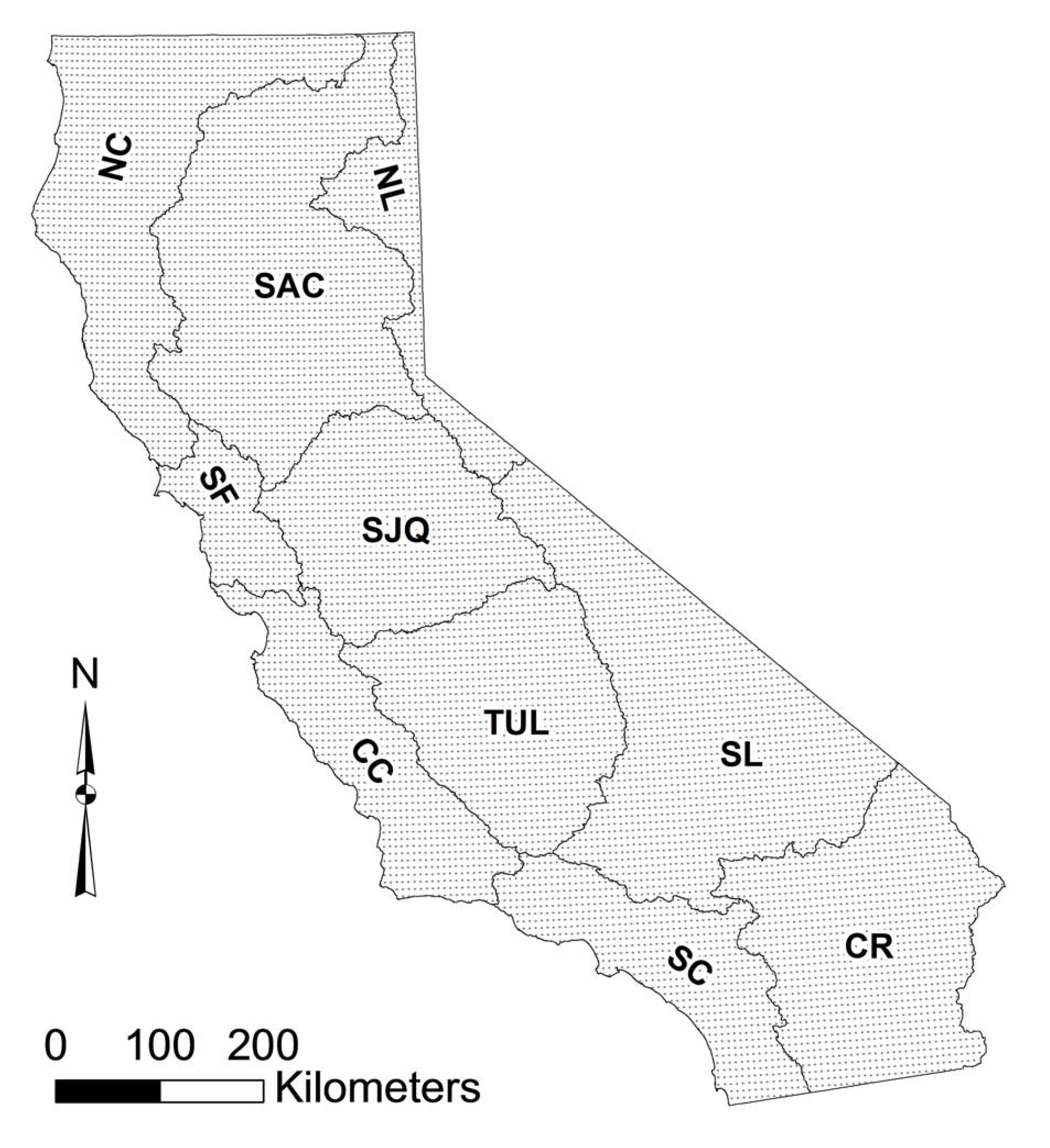
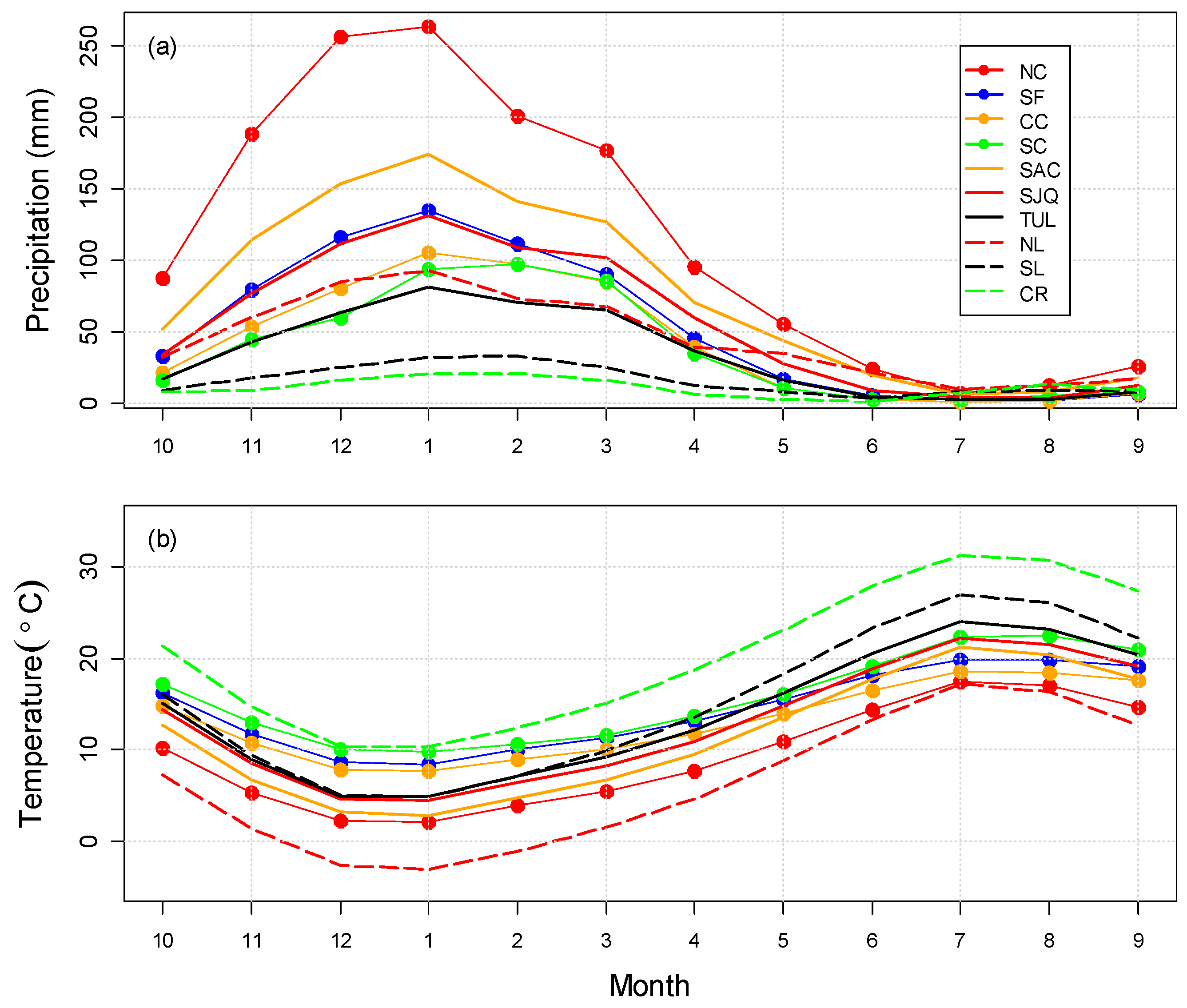
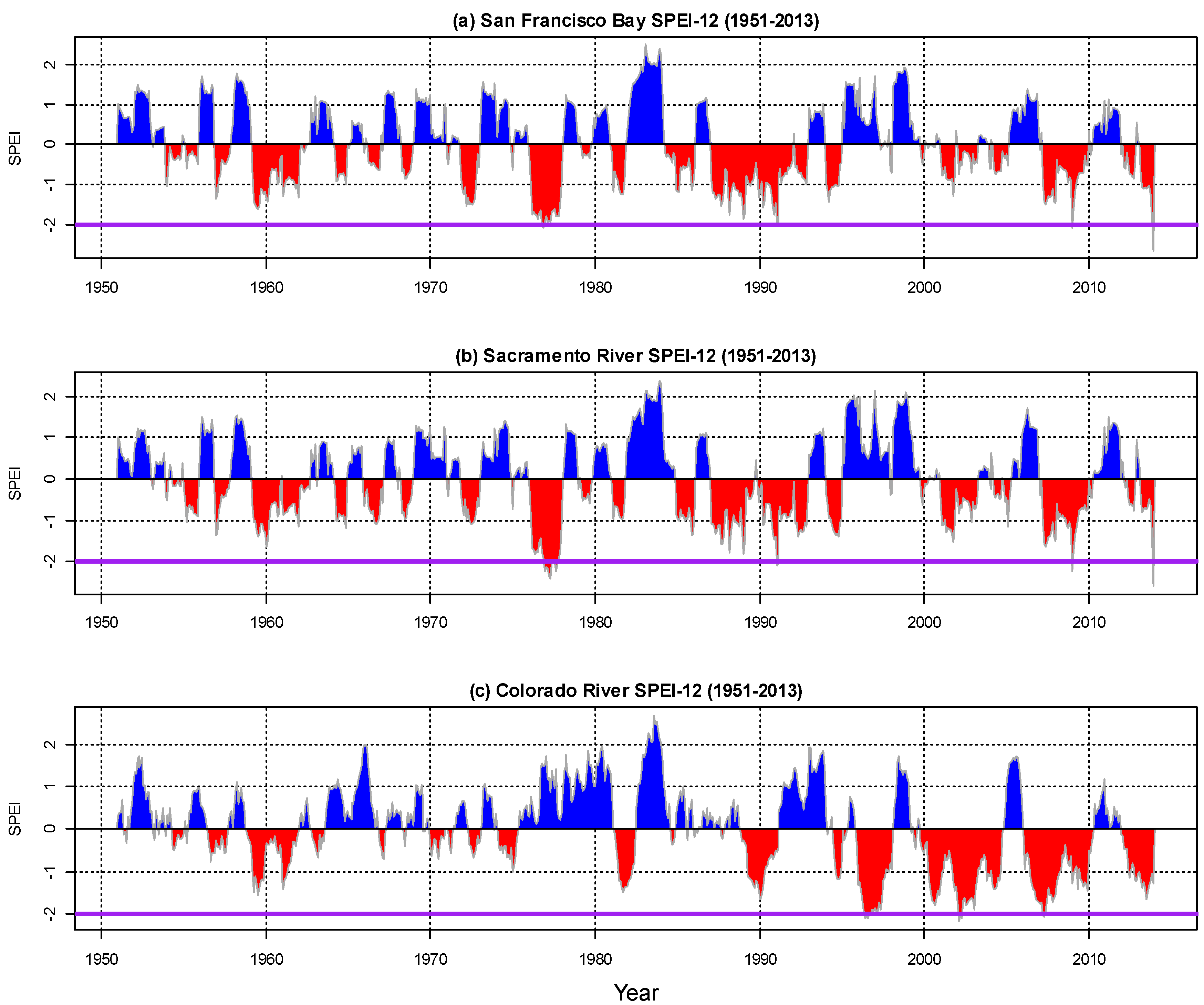
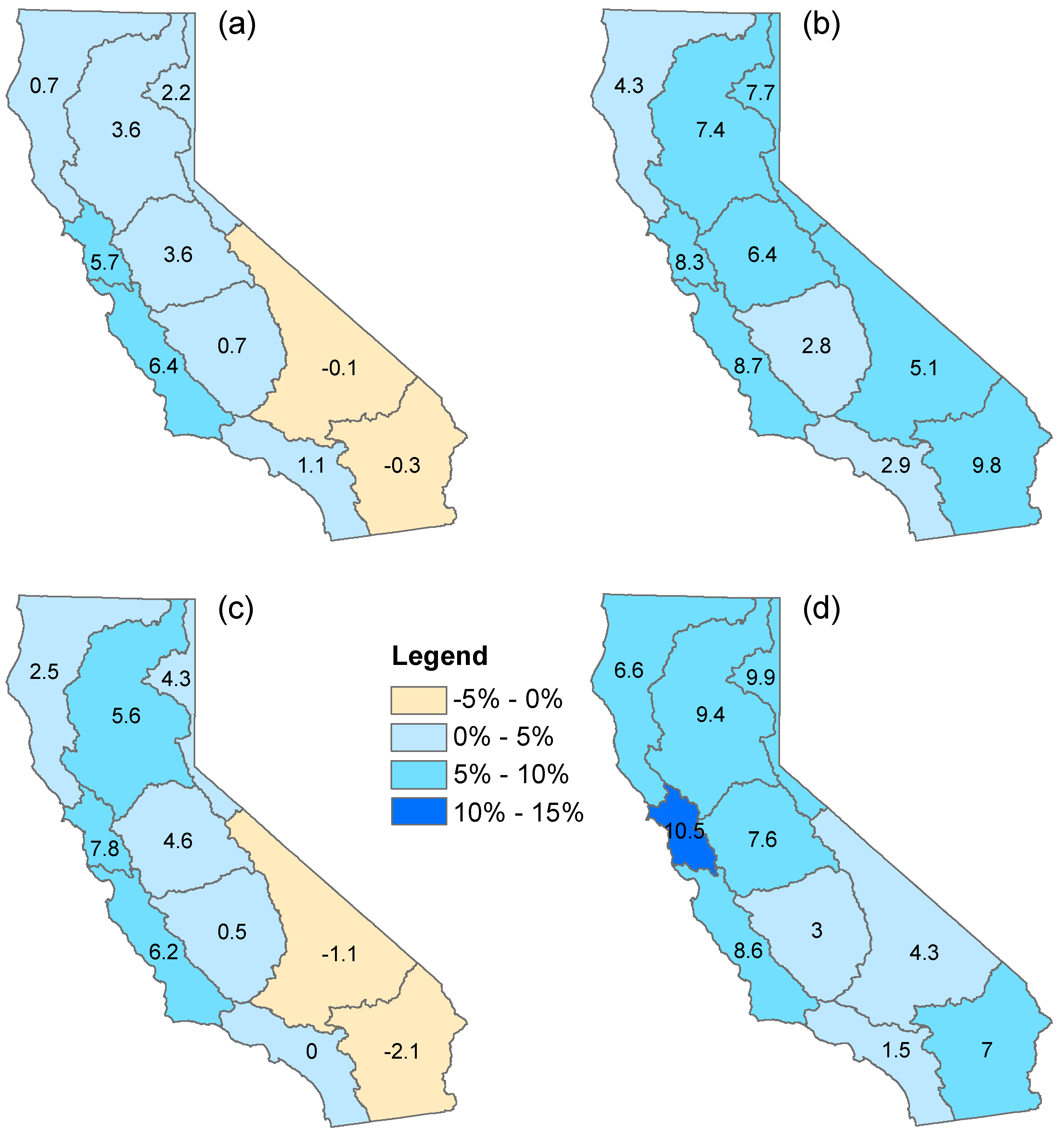
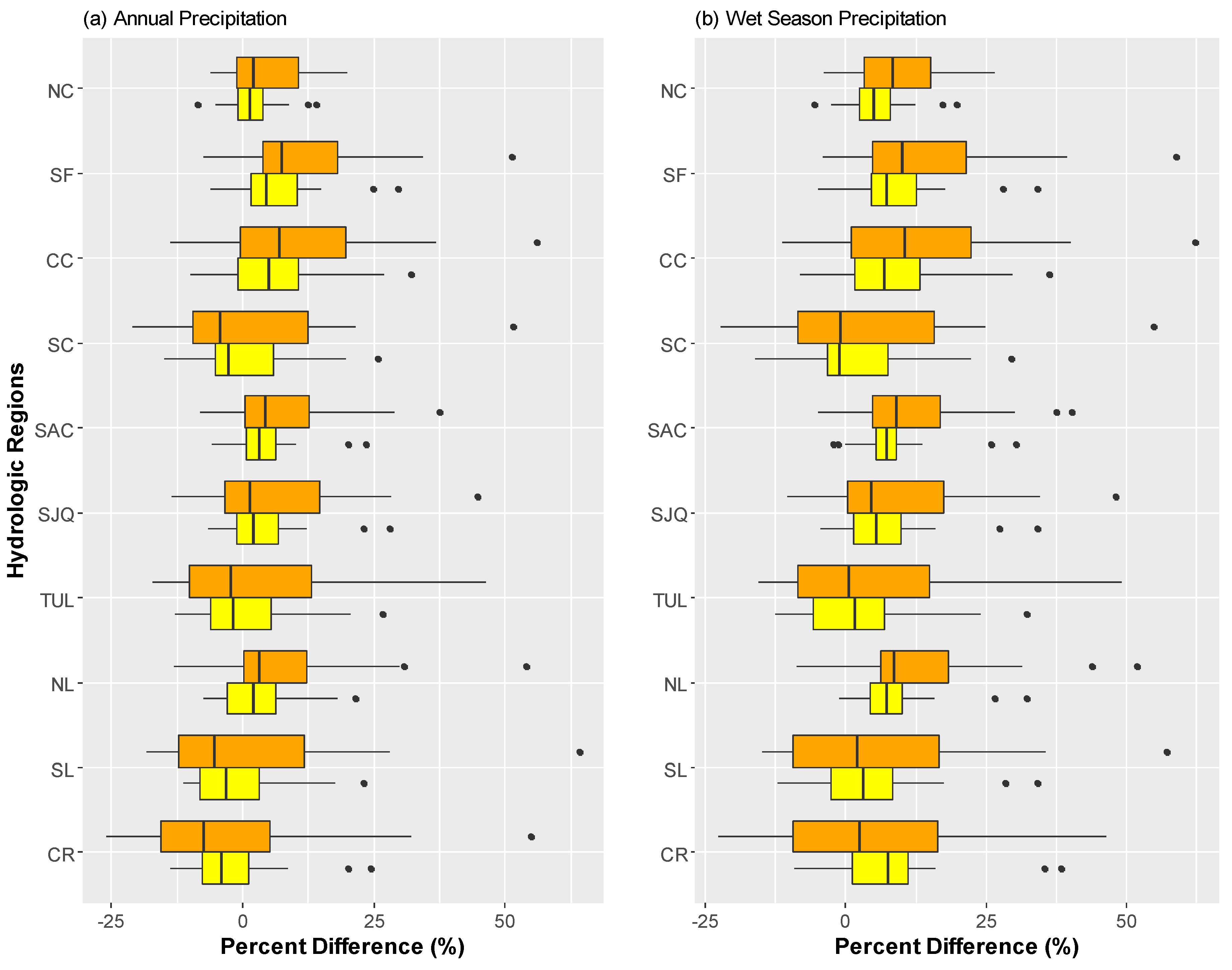
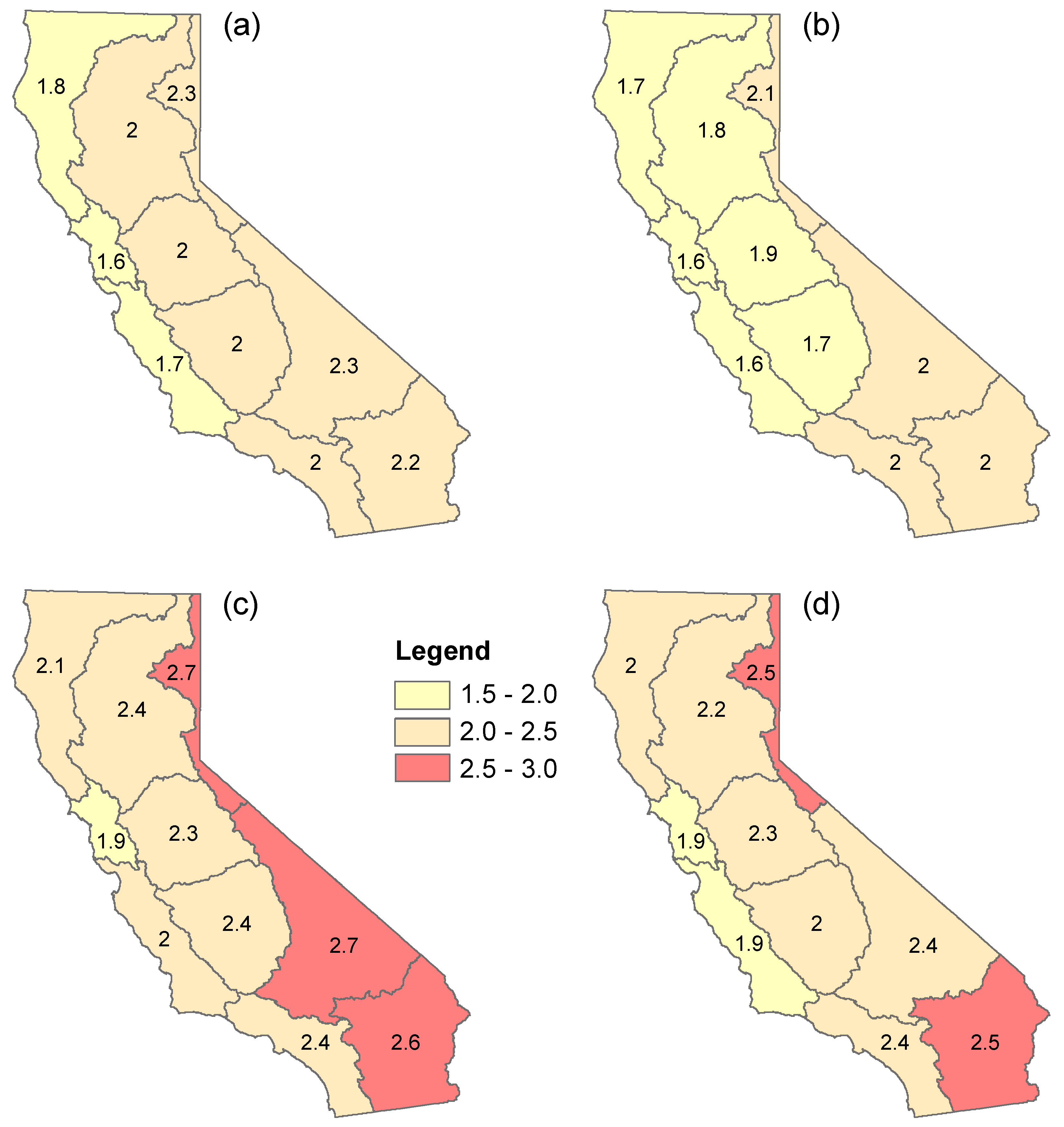
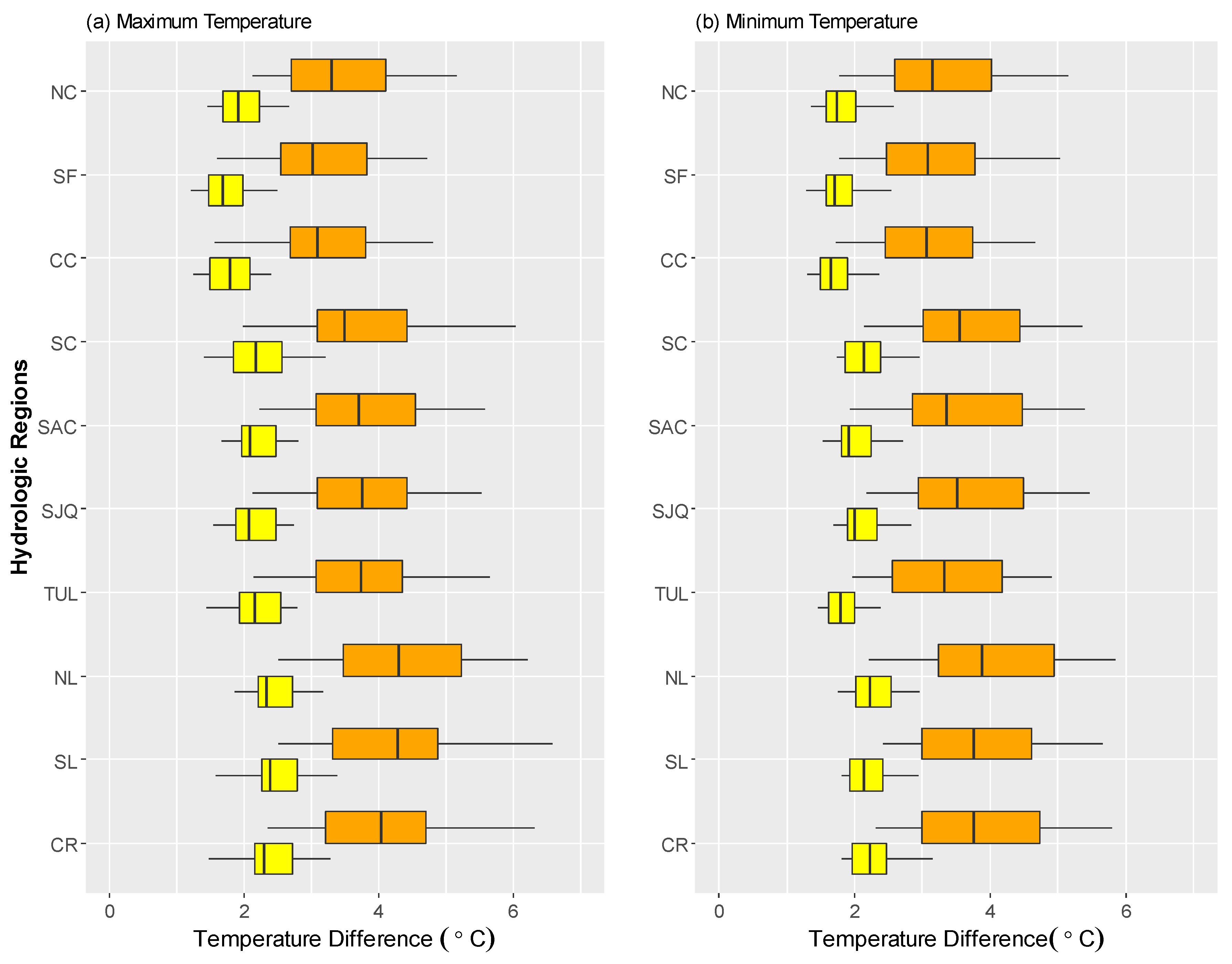
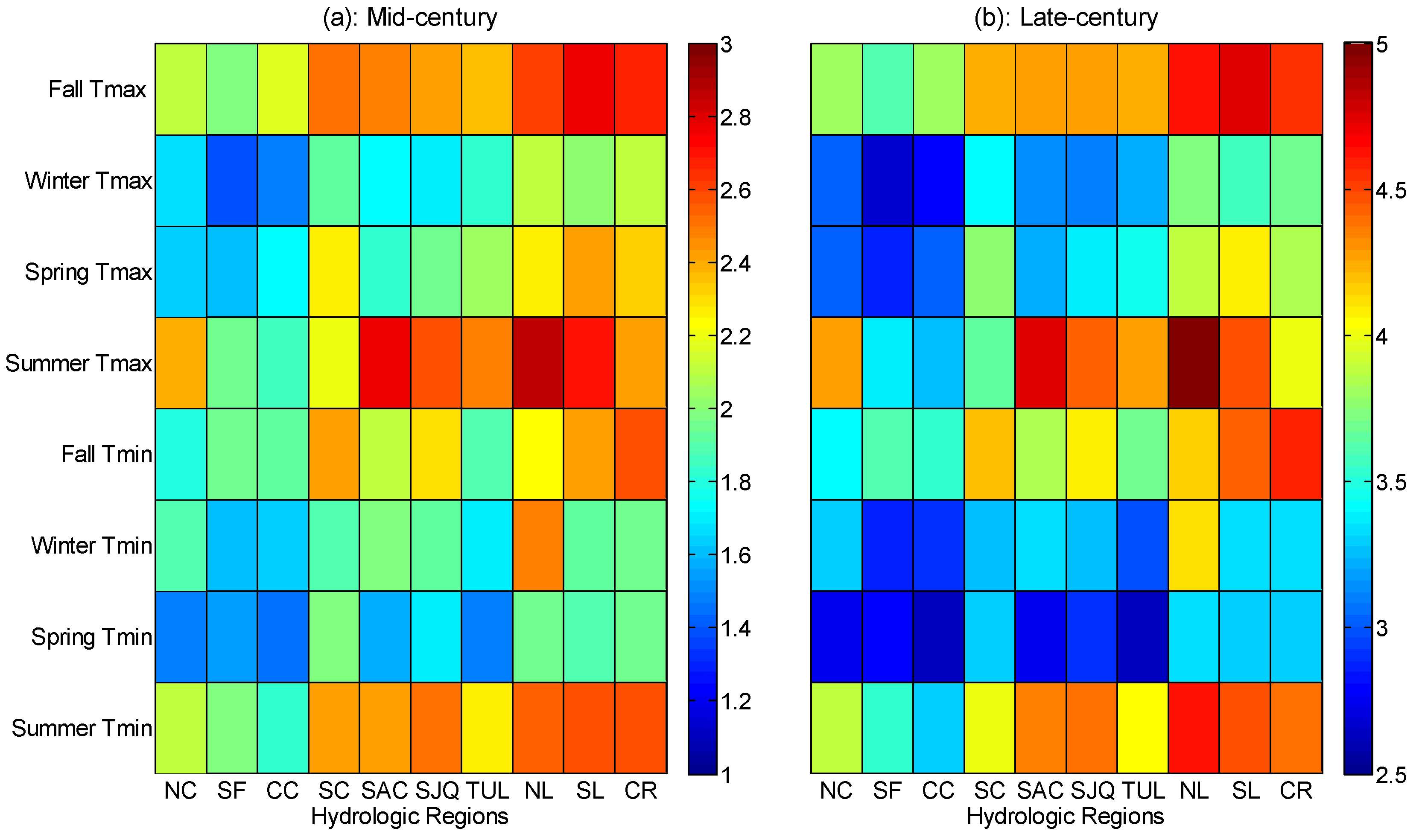
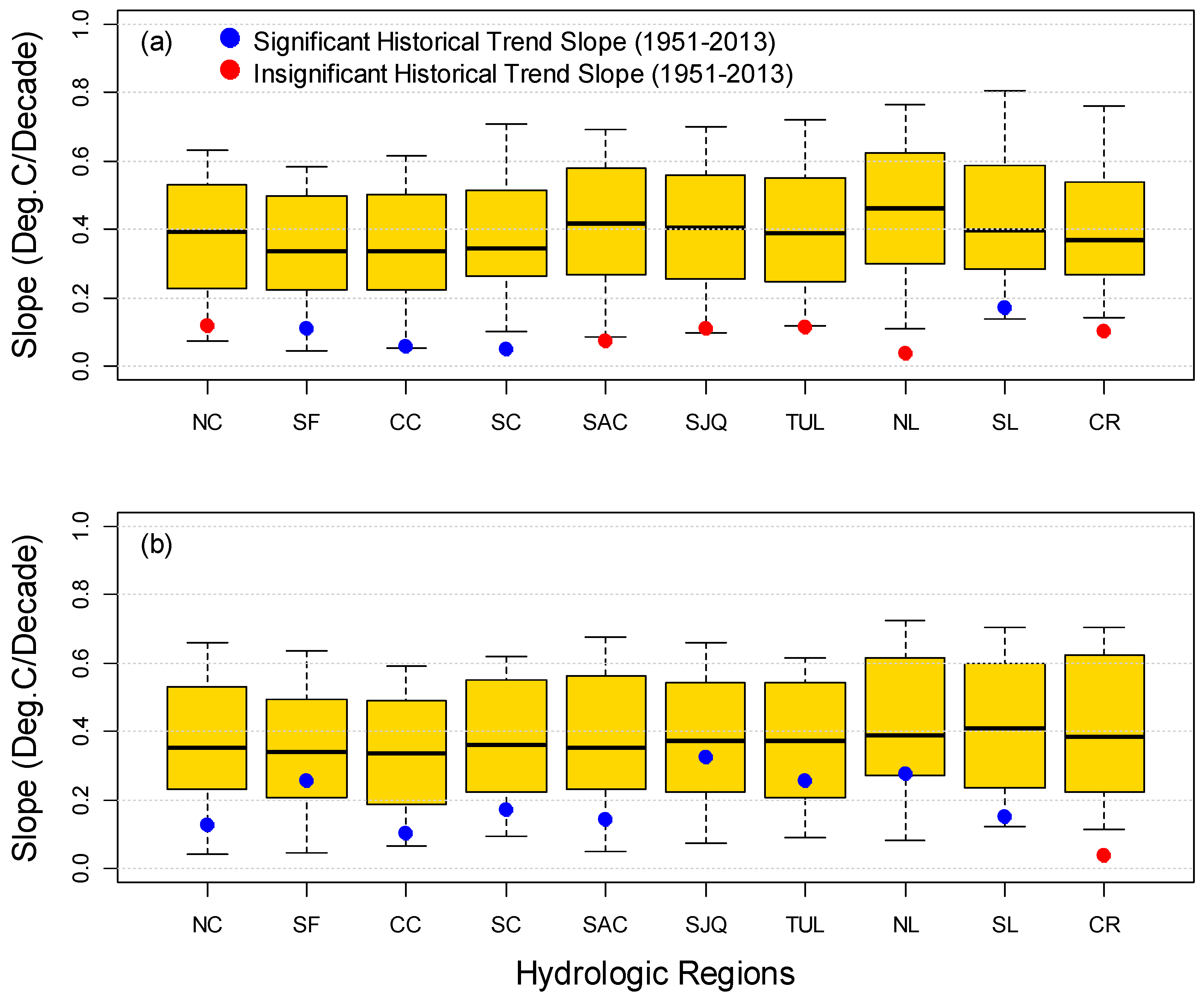
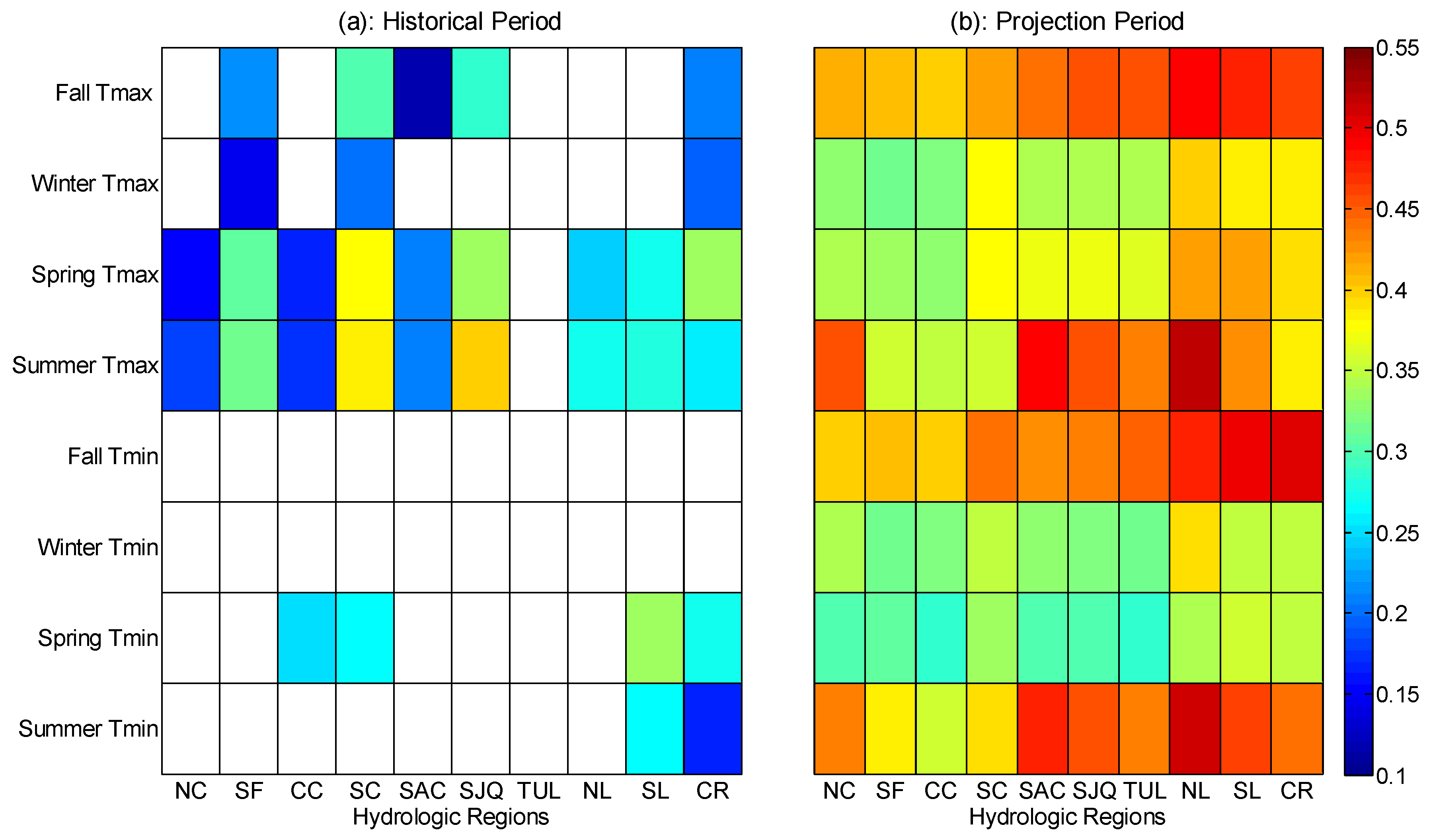
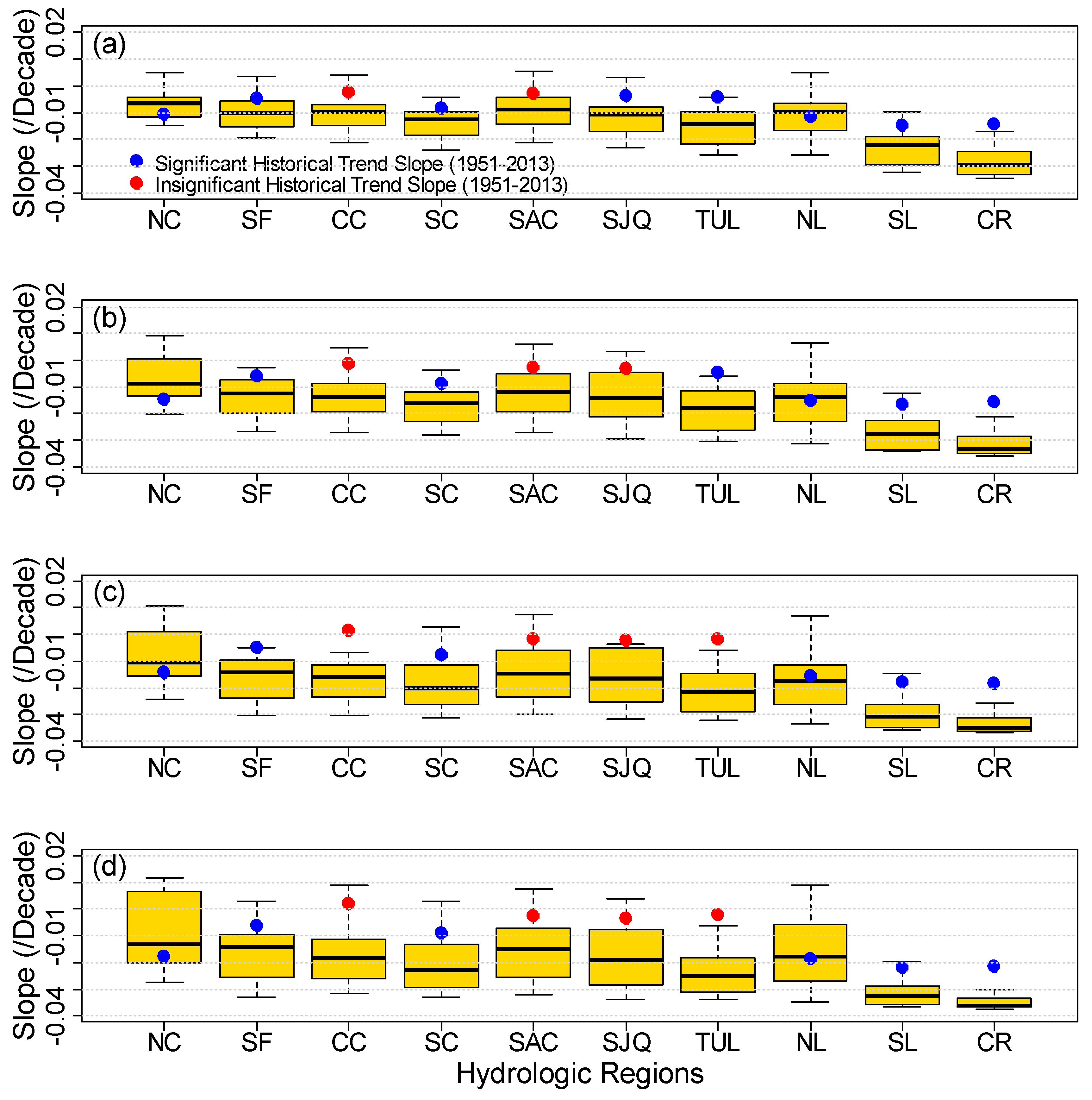
| ID | Region Name | Area (km2) | Annual Precipitation (mm) | Annual Mean Temperature (°C) | Population (as of 2010; Million) |
|---|---|---|---|---|---|
| NC | North Coast | 49,859 | 1390 | 9.3 | 0.81 |
| SF | San Francisco Bay | 11,535 | 641 | 14.3 | 6.35 |
| CC | Central Coast | 28,995 | 504 | 13.0 | 1.53 |
| SC | South Coast | 27,968 | 459 | 15.6 | 19.58 |
| SAC | Sacramento River | 69,750 | 925 | 11.4 | 2.98 |
| SJQ | San Joaquin River | 38,948 | 680 | 12.8 | 2.10 |
| TUL | Tulare Lake | 43,604 | 408 | 13.9 | 2.27 |
| NL | North Lahontan | 15,672 | 542 | 6.4 | 0.11 |
| SL | South Lahontan | 68,434 | 191 | 15.2 | 0.93 |
| CR | Colorado River | 51,103 | 127 | 20.2 | 0.75 |
| Model ID | Model Name | Model Institution |
|---|---|---|
| 1 | ACCESS-1.0 | Commonwealth Scientific and Industrial Research Organisation (CSIRO) and Bureau of Meteorology (BOM), Australia |
| 2 | CCSM4 | National Center for Atmospheric Research |
| 3 | CESM1-BGC | National Science Foundation, Department of Energy, National Center for Atmospheric Research |
| 4 | CMCC-CMS | Centro Euro-Mediterraneo sui Cambiamenti Climatici |
| 5 | CNRM-CM5 | Centre National de Recherches Météorologiques/Centre Européen de Recherche et de Formation Avancée en Calcul Scientifique |
| 6 | CanESM2 | Canadian Centre for Climate Modeling and Analysis |
| 7 | GFDL-CM3 | Geophysical Fluid Dynamics Laboratory |
| 8 | HadGEM2-CC | Met Office Hadley Centre |
| 9 | HadGEM2-ES | Met Office Hadley Centre/Instituto Nacional de Pesquisas Espaciais |
| 10 | MIROC5 | Atmosphere and Ocean Research Institute (The University of Tokyo), National Institute for Environmental Studies, and Japan Agency for Marine-Earth Science and Technology |
| ID | Region Name | Annual Precipitation (%) | Wet Season Precipitation (%) | ||
|---|---|---|---|---|---|
| Mid-Century | Late-Century | Mid-Century | Late-Century | ||
| NC | North Coast | 4.4 | 5.2 | 8.4 | 10.6 |
| SF | San Francisco Bay | 10.3 | 14.4 | 12.7 | 18.7 |
| CC | Central Coast | 7.4 | 12.8 | 9.6 | 16.0 |
| SC | South Coast | −0.1 | 1.4 | 1.4 | 3.9 |
| SAC | Sacramento River | 7.6 | 9.0 | 11.4 | 14.2 |
| SJQ | San Joaquin River | 5.4 | 7.4 | 8.0 | 11.3 |
| TUL | Tulare Lake | 0.5 | 2.7 | 2.9 | 5.8 |
| NL | North Lahontan | 6.6 | 10.3 | 11.8 | 16.9 |
| SL | South Lahontan | −0.5 | 2.4 | 3.8 | 7.7 |
| CR | Colorado River | −2.3 | −1.5 | 4.7 | 5.9 |
| Annual Tmax (°C) | Annual Tmin (°C) | ||||
|---|---|---|---|---|---|
| Mid-Century | Late-Century | Mid-Century | Late-Century | ||
| NC | North Coast | 2.7 | 4.3 | 2.5 | 4.1 |
| SF | San Francisco Bay | 2.4 | 3.8 | 2.5 | 4.0 |
| CC | Central Coast | 2.5 | 3.9 | 2.4 | 3.8 |
| SC | South Coast | 3.0 | 4.5 | 2.9 | 4.5 |
| SAC | Sacramento River | 3.0 | 4.7 | 2.7 | 4.4 |
| SJQ | San Joaquin River | 3.0 | 4.6 | 2.8 | 4.5 |
| TUL | Tulare Lake | 3.0 | 4.6 | 2.5 | 4.2 |
| NL | North Lahontan | 3.4 | 5.3 | 3.2 | 5.0 |
| SL | South Lahontan | 3.3 | 5.1 | 3.0 | 4.8 |
| CR | Colorado River | 3.2 | 4.9 | 3.0 | 4.9 |
| ID | Region Name | Number (Percent) of Projections with Significant Trend 1 | Range of Significant Trend Slope (mm/Year) | |
|---|---|---|---|---|
| Annual Precipitation | Wet Season Precipitation | |||
| NC | North Coast | 2 (10%) | 3 (15%) | 3.9~5.4 |
| SF | San Francisco Bay | 2 (10%) | 2 (10%) | 3.2~4.6 |
| CC | Central Coast | 3 (15%) | 3 (15%) | −0.5~3.4 |
| SC | South Coast | 1 (5%) | 1 (5%) | 2.1~2.7 |
| SAC | Sacramento River | 1 (5%) | 3 (15%) | −2.2~6.0 |
| SJQ | San Joaquin River | 2 (10%) | 2 (10%) | 2.8~5.0 |
| TUL | Tulare Lake | 2 (10%) | 2 (10%) | 1.7~3.2 |
| NL | North Lahontan | 3 (15%) | 3 (15%) | 1.2~5.3 |
| SL | South Lahontan | 2 (10%) | 0 (0%) | 0.8~1.9 |
| CR | Colorado River | 1 (5%) | 0 (0%) | 1.1 |
| ID | Region Name | SPEI-12 | SPEI-24 | SPEI-36 | SPEI-48 |
|---|---|---|---|---|---|
| NC | North Coast | 6 (30%) | 5 (25%) | 5 (25%) | 6 (30%) |
| SF | San Francisco Bay | 5 (25%) | 5 (25%) | 5 (25%) | 3 (15%) |
| CC | Central Coast | 3 (15%) | 3 (15%) | 3 (15%) | 2 (10%) |
| SC | South Coast | 1 (5%) | 1 (5%) | 0 (0%) | 0 (0%) |
| SAC | Sacramento River | 4 (20%) | 3 (15%) | 4 (20%) | 3 (15%) |
| SJQ | San Joaquin River | 3 (15%) | 2 (10%) | 2 (10%) | 2 (10%) |
| TUL | Tulare Lake | 1 (5%) | 1 (5%) | 1 (5%) | 1 (5%) |
| NL | North Lahontan | 2 (10%) | 3 (15%) | 3 (15%) | 0 (0%) |
| SL | South Lahontan | 0 (0%) | 0 (0%) | 0 (0%) | 0 (0%) |
| CR | Colorado River | 0 (0%) | 0 (0%) | 0 (0%) | 0 (0%) |
© 2018 by the authors. Licensee MDPI, Basel, Switzerland. This article is an open access article distributed under the terms and conditions of the Creative Commons Attribution (CC BY) license (http://creativecommons.org/licenses/by/4.0/).
Share and Cite
He, M.; Schwarz, A.; Lynn, E.; Anderson, M. Projected Changes in Precipitation, Temperature, and Drought across California’s Hydrologic Regions in the 21st Century. Climate 2018, 6, 31. https://doi.org/10.3390/cli6020031
He M, Schwarz A, Lynn E, Anderson M. Projected Changes in Precipitation, Temperature, and Drought across California’s Hydrologic Regions in the 21st Century. Climate. 2018; 6(2):31. https://doi.org/10.3390/cli6020031
Chicago/Turabian StyleHe, Minxue, Andrew Schwarz, Elissa Lynn, and Michael Anderson. 2018. "Projected Changes in Precipitation, Temperature, and Drought across California’s Hydrologic Regions in the 21st Century" Climate 6, no. 2: 31. https://doi.org/10.3390/cli6020031
APA StyleHe, M., Schwarz, A., Lynn, E., & Anderson, M. (2018). Projected Changes in Precipitation, Temperature, and Drought across California’s Hydrologic Regions in the 21st Century. Climate, 6(2), 31. https://doi.org/10.3390/cli6020031





